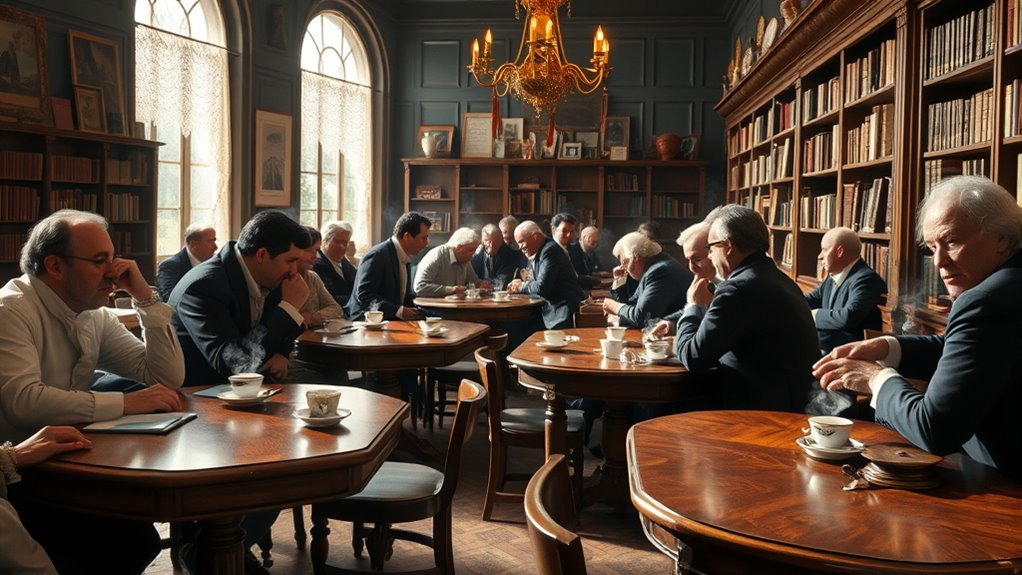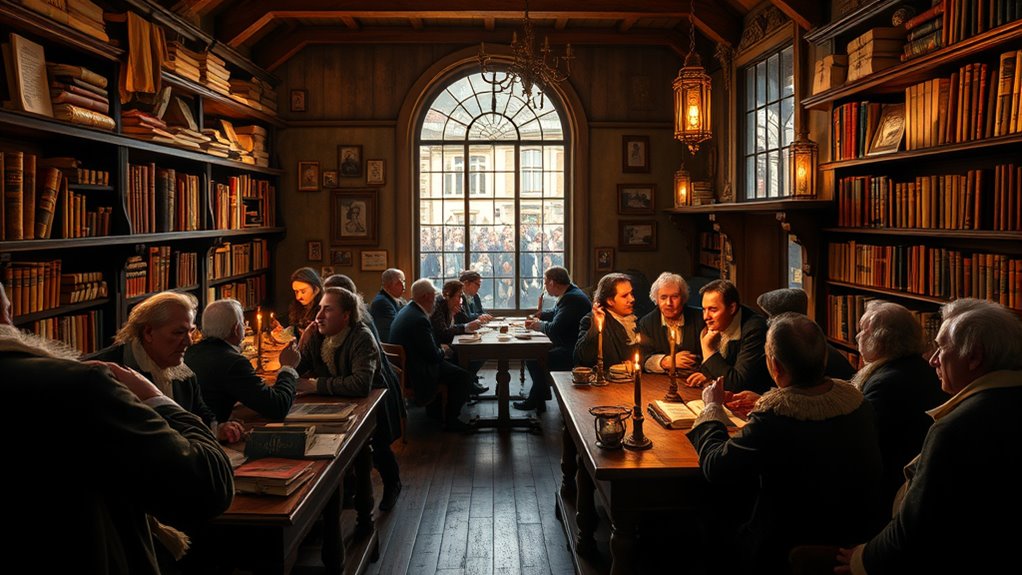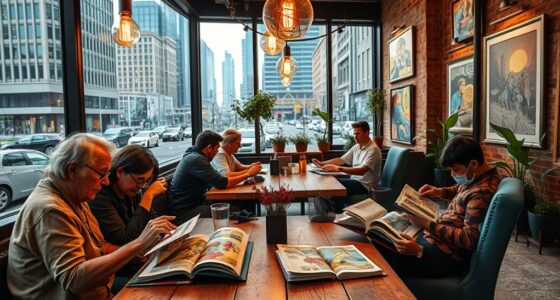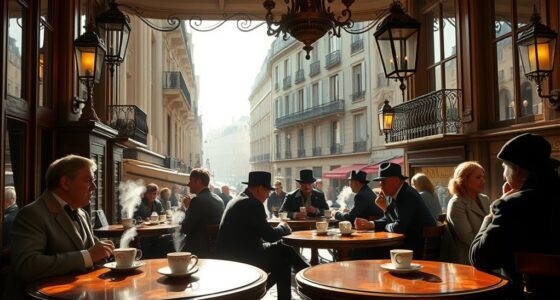During the Enlightenment, coffeehouses became lively hubs where you could mingle with people from all walks of life. They fostered debates on politics, science, and society, driven by the spread of print culture like newspapers and pamphlets. These spaces broke social barriers and encouraged critical thinking, helping spread revolutionary ideas. If you keep exploring, you’ll discover how these venues shaped history through social networking and daring ideas that challenged the status quo.
Key Takeaways
- Coffeehouses served as accessible venues for lively debates fueled by print media like newspapers and pamphlets.
- They facilitated the rapid spread of revolutionary ideas and reformist thoughts through print culture.
- Coffeehouses promoted open discussion across social classes, encouraging critical thinking and questioning authority.
- Print materials in coffeehouses amplified ideas beyond physical space, mobilizing wider audiences for social change.
- These spaces were crucial for intellectual exchange, fostering political activism and shaping revolutionary movements.

Have you ever wondered why coffeehouses became such indispensable hubs during the Enlightenment? These lively venues weren’t just places to enjoy a good brew; they served as vibrant centers of social networking and political activism. As you step into a typical 18th-century coffeehouse, you’ll notice how quickly conversations flow, ideas spread, and connections form. Unlike the more formal settings of salons or academies, coffeehouses offered an accessible space where people from various backgrounds could mingle freely. This democratization of discussion meant that social networking wasn’t limited to the elite anymore. Instead, merchants, students, writers, and even government officials gathered to exchange news, debate ideas, and challenge traditional authority. You might find yourself sitting next to a merchant discussing new trade routes or a scholar sharing insights about natural philosophy—all over cups of coffee. This environment fostered a sense of community where different social classes interacted, breaking down barriers that previously kept ideas confined to specific groups. It was here that the seeds of political activism were sown, as people became more aware of their collective power and the possibilities for change. Coffeehouses provided a platform for citizens to voice opinions about government policies, taxation, and individual rights. When you listen to the conversations, you realize how these debates often challenged the status quo, encouraging critical thinking and questioning authority figures. Writers and pamphleteers found coffeehouses to be fertile ground for testing new ideas and rallying support for reform. The immediacy of face-to-face discussion meant that revolutionary thoughts could spread quickly, sometimes leading to coordinated efforts for political change. Furthermore, the print culture thriving within coffeehouses—newspapers, pamphlets, and leaflets—amplified the reach of these ideas beyond the physical space, helping to mobilize broader audiences. You can imagine how exhilarating it must have been to be part of these conversations, knowing that your words could influence the course of history. Essentially, coffeehouses not only fueled intellectual and cultural exchange but also played a crucial role in fostering social networking and political activism, making them vital spaces for the revolutionary spirit of the Enlightenment. The print culture within coffeehouses was vital in ensuring that ideas circulated rapidly and reached a wider public, further enhancing their influence.
Frequently Asked Questions
How Did Coffeehouses Influence Political Revolutions During the Enlightenment?
You see, coffeehouses fueled political revolutions by becoming hubs of cultural exchange, where ideas spread rapidly. People gathered to debate and challenge authority, often sharing revolutionary thoughts. These venues also fostered artistic patronage, inspiring revolutionary art and literature. As a result, coffeehouses played a vital role in shaping public opinion, mobilizing citizens, and ultimately igniting political upheavals during the Enlightenment.
What Types of Debates Were Most Common in Enlightenment Coffeehouses?
In enlightenment coffeehouses, you often engaged in philosophy debates and scientific discussions. These debates covered ideas about government, liberty, and reason, encouraging critical thinking. You might have discussed new scientific discoveries or challenged traditional beliefs, fostering an environment of intellectual exchange. Coffeehouses became lively spaces where you could freely share ideas, question authority, and explore the principles that shaped modern thought during the Enlightenment.
Who Were the Most Prominent Figures Associated With Enlightenment Coffeehouse Culture?
You’d find prominent figures associated with enlightenment coffeehouse culture like salon intellectuals and scientific correspondents. These individuals, such as Voltaire and Diderot, often gathered in coffeehouses to exchange ideas, debate philosophy, science, and politics, fueling intellectual growth. Their lively discussions helped spread Enlightenment ideals, shaping public opinion and fostering a vibrant culture of inquiry and debate that influenced broader societal change.
How Did Print Culture Spread Ideas Through Coffeehouse Discussions?
You might think coffeehouses only served drinks, but they also spread ideas through print culture. You can see how artistic expressions and scientific advancements traveled quickly as patrons shared pamphlets, newspapers, and books. These discussions helped ideas spread beyond their origins, making coffeehouses hubs of innovation. Your active participation in conversations allowed new knowledge to circulate rapidly, fueling the Enlightenment’s progress and connecting thinkers across social boundaries.
Were There Any Differences in Coffeehouse Culture Across European Cities?
You’ll notice that coffeehouse culture varies across European cities due to regional customs and architectural styles. In some places, like London, coffeehouses are bustling and informal, reflecting local social norms. In contrast, Parisian cafes exhibit elegant architecture and a focus on artistic debate. These differences shape how ideas spread and how people engage in discussions, with each city’s unique style influencing the intellectual atmosphere.
Conclusion
As you reflect on the role of coffeehouses during the Enlightenment, it’s clear they weren’t just places for a quick caffeine fix but vibrant hubs of debate and ideas. They fostered a culture of inquiry that transformed society. Can you imagine how different history might be if these spaces hadn’t sparked critical thinking and conversation? Ultimately, coffeehouses remind us that sometimes, a simple cup of coffee can ignite revolutionary change.









